
Can my paralyzed dog regain deep pain sensation? It’s an important question to ask after your pet’s had a spine injury or surgery. The ability to feel pain could point to signs of recovery for a paralyzed dog. It could be an indicator the nerves in the spinal cord are, at some level, communicating with the brain.
Everyone knows paralysis means the inability to move, but it’s also defined as the inability to feel sensations. Veterinarians check for both when they try to determine the level of paralysis. They can visually see whether a dog can move their limbs, but they can’t tell what a pup feels when their belly gets rubbed.
So, they turn to an exam called the Pinch Test to see if a reaction can be produced by an uncomfortable sensation.

Ask & Discover
Get personalized content recommendations and answers drawn from our website. Simply type your question or topic of interest, and our AI assistant will help you find relevant articles, tips, and insights. You can also have a natural conversation to explore topics in more depth.
Understanding Deep Pain Sensation
The awareness of pain and pressure in the deep layers of the skin, muscles and joints is defined as having deep pain sensation. It’s a hopeful sign and a good prognosis for the recovery of a paralyzed dog.
Veterinarians test for pain because it elicits a big reaction.
The Rehab Vet explains that dogs are assessed when they show these signs:
- Unable to walk, even one step with the hind legs.
- Can’t use their back legs to push up from the floor, even when their body is supported.
- Can’t make any deliberate movements with the hind legs.
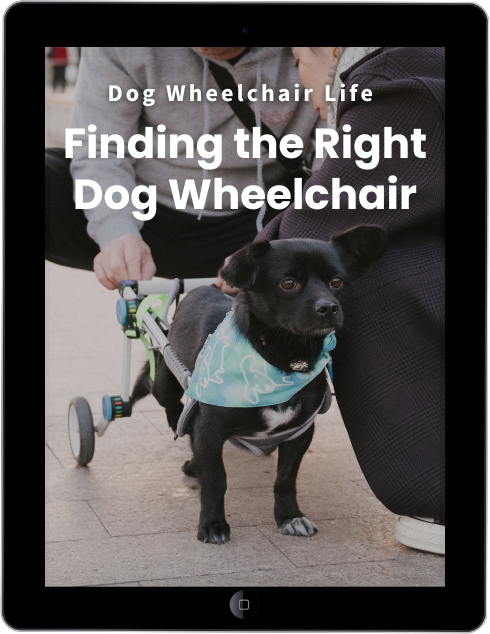
eBook
Find The Right Dog Wheelchair For Your Pet
Your dog has a mobility problem, and you want to buy a wheelchair. But do you know what kind of cart will work best for your dog’s individual needs? After a decade of teaching pet owners how to make the right choice, I put the information into an eBook!
The Pinch Test
The test is given to dogs with hind end weakness or paralysis due to Intervertebral Disc Disease (IVDD), Degenerative Myelopathy, FCE strokes, Hemivertebrae, ruptured discs and spinal cord injuries.
It consists of squeezing one of your dog’s toes on the paralyzed limb with firm and increasing pressure. The pinch should only last a few seconds. It can also be administered to a dog’s tail.
During the test, veterinarians look for a very specific response. Some dogs jerk their leg away, but this isn’t the reaction they want to see. This is an involuntary reflex and not a deliberate response.
For the pinch test to be successful, an intentional and calculated reaction is required.
Your vet hopes your dog will look at the person squeezing their toe with an expression that says, “Stop doing that.”
Loss of deep pain varies with different health conditions
The type of spine or neurologic problem your dog has, influences how quickly deep pain sensation is lost. For instance, dogs with Degenerative Myelopathy, a progressive neurologic condition, pass the pinch test during the early months of their disease. They lose the response as their condition worsens.
Dogs who rupture a disc due to IVDD or experience a spinal cord injury, such as being hit by a car or having a stroke, lose their pain response at the onset.
It’s also a different story for dogs who undergo spine surgery. While they lose pain sensations quickly, it can also be one of the first signs of recovery. Statistically dogs who eventually beat paralysis and walk again, start to experience pain sensation during the first 24 hours after surgery.
Click here to read more about understanding IVDD
Physical therapy helps
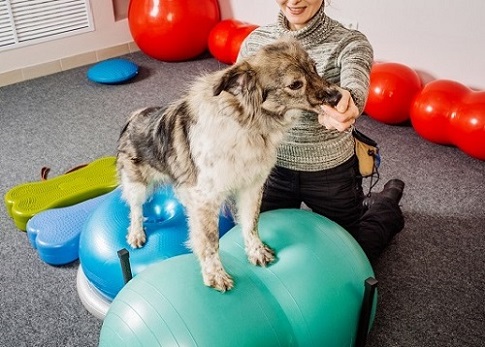
(Be sure to talk with your dog’s veterinarian before starting these exercises with your dog.)
Canine rehabilitation therapists use a variety of exercises to increase mobility and the awareness of pain in paralyzed dogs. Two exercises are often recommended for the recovery during the early stages of recovery when dogs first come home from the hospital.
Massage
Gentle massage up and down your dog’s body is used to improve circulation and improve muscle tone. Place your pet on their side while you massage each major muscle group. Then help your dog flip to the other side while you repeat slow, easy massage. This should be done 3 times a day during the first week of recovery.

Get the Essential Guide
The Essential Guide of Products for Handicapped Dogs e-book is a labor of love for me. I wrote it to answer your most pressing questions about where to find the best products for your wheelchair dog. You’ll find products you didn’t know existed and each will improve your dog’s quality of life. Print a copy and keep it by your side.
Toe Squeeze
To do the exercise, pull or squeeze the toes on each affected paw and then release. Your touch should be firm, but NOT hard enough to injure your dog.
Remember, if your dog has lost sensations, they won’t be able to tell you if your touch hurts, so go slow.
If you do this exercise on an able-bodied dog, they’ll automatically pull their leg away from the pinch. The goal is to see if your dog can relearn this response.
Do this exercise several times a day during the first week your pup comes home from the hospital.
Click here to read about more exercises you can do with your dog at home.
My dog’s experience
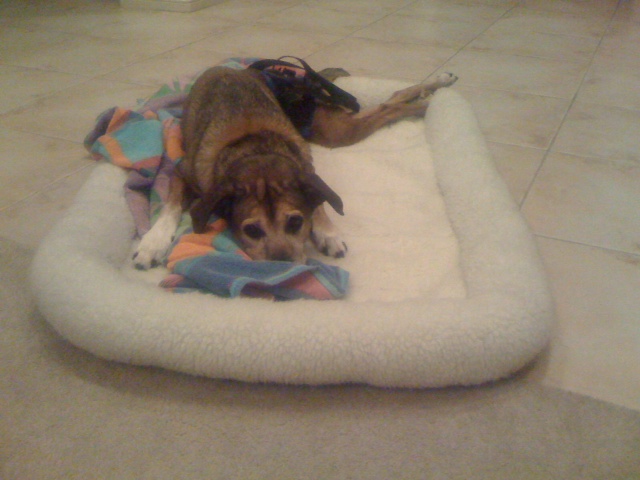
Sophie had a progressive neurological condition. She had pinch tests from every specialist we saw. The course of her disease went slow and it took nearly 6 months for her to lose her reaction to pain.
At first, she had a strong response to the pinch test. She would yank her whole leg away from the discomfort.
But finally, the day came when our vet pinched her toe and she didn’t realize he was touching her.
Don’t give up hope
In my opinion, there are more options available to pet families today. Canine physical therapists, hydrotherapy specialists and rehab vets can work wonders to increase the strength and mobility of disabled pets. And if there isn’t a rehab center in your city, there are lots of exercises you can do at home with your pup.
Dog Wheelchair LIFE has an Amazon Shop with specialized supplies for your wheelchair dog. Click Here to Enter.

C


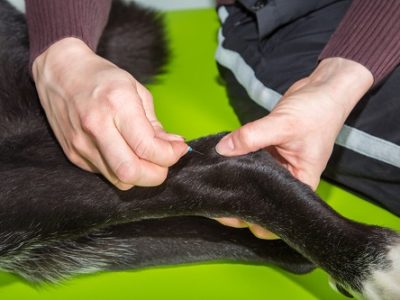
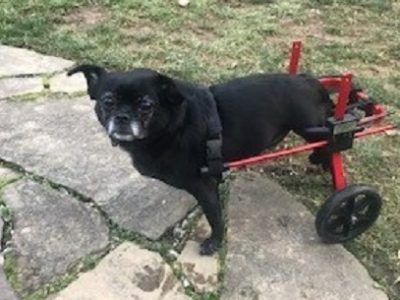
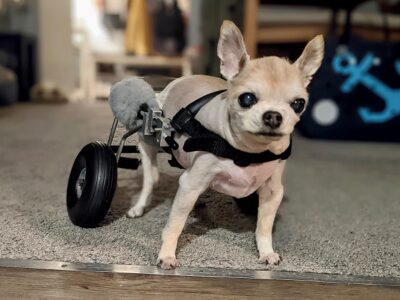
My best advice to an owner with a suddenly paralyzed dog is this.
Your vet’s initial neurological exam is usually done within the first few hours of your dog “going down”.
This exam can be very discouraging to an owner. But, don’t give up hope if your vet has a less than optimistic opinion after the exam.
In my 30 some years as a technician and 22 years of building wheelchairs, I have learned that an early neurological exam after a spinal cord injury will usually have a more “glass half empty” vibe.
There is always a large amount of inflammation in the traumatized area and the dog’s whole body is in shock, trying to send every resource to begin the healing process.
Because of this, it’s my experience that having a recheck, re-evaluation exam in a couple of weeks will reveal a truer long term picture of the healing potential.
Letting that shocky spinal cord calm down and relieving the massive amount of inflammation can really produce a very different, more positive outlook for recovery.
I am always saddened to hear that a vet has given a dog with a very fresh cord injury a grim prognosis, even recommending euthanasia due to their initial exam findings.
So, I always tell owners to follow their heart before making that decision. Does your dog seem painful? Is the light still in their eyes? Is paralysis the only thing making your dog “not normal” as usual?
In these cases, I would always suggest giving them time to see what happens.
In my career, I have seen thousands of dogs recover eventhough their vet didn’t think that would happen. My own Dachshund, Penny was that dog! She had questionable deep pain 3 weeks post op. She was otherwise bright and just being herself. My vet (also my boss) doubted she would ever walk again. I didn’t give up, I started PT, built her a wheelchair and in 5 months, she walked!!
So, it can happen. It seems miraculous, but dog’s are little healing machines. Sometimes they just need a chance and lots of good nursing care.
Laurie, Thank you so much for sharing your expertise on this issue.
Hi Laurie, thanks for sharing. My dog had slipped disc surgery 2 months ago at this point. He’s still unable to walk, control his bladder, and doesn’t have deep pain. The surgeon said it was permanent after the first month but I’m still holding out hope although he hasn’t shown improvement since. I’ve been doing passive range of motion exercises and some quick walks in a sling but that’s about it. I’m not sure how much longer I should hold out hope if he continues to stay the same.